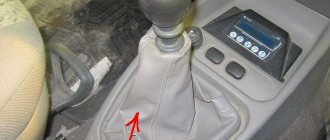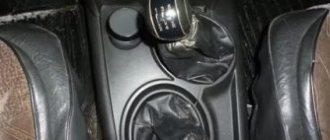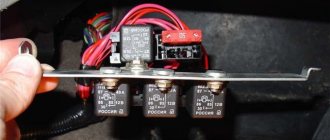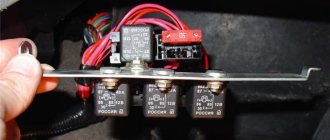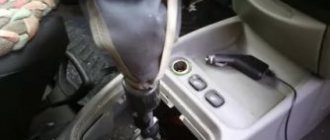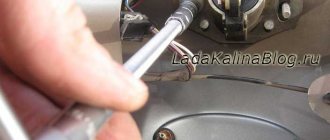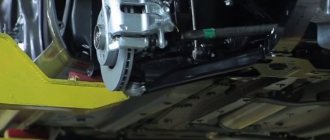During operation, the owners of the domestic Lada Kalina model identified a transmission flaw; reverse gear does not engage. There are several reasons that cause a malfunction of this nature. A modern car is stuffed with electronic devices, one of which can also serve as the initiator of this breakdown.
In our article we will try to touch in detail on the problem when the reverse gear in the transmission unit does not engage. Let's consider the reasons that cause this malfunction, as well as methods that allow you to independently find and eliminate the unpleasant defect.
Is there no way to engage reverse? What are the reasons?
- At the very beginning, you should not rush and frantically dismantle and disassemble such a complex unit as a gearbox if the reverse gear does not engage. You should take a closer look at the shift lever; perhaps the reason is hidden there. The link paired with the cardan in the switching mechanism are quite often the culprits of such a breakdown. There is no way to do without a viewing hole here.
- Among the probable reasons when the reverse speed does not work may be a failed release bearing. However, such a development of events would inevitably lead to the inability to normally engage any gear, and the process itself would be determined by the presence of crunches and difficulties.
- Also, when the reverse gear does not work, the reverse gear locking mechanism on the Lada Kalina may break down. To determine whether there is a malfunction, you will need to remove the shift lever handle and visually inspect this unit.
- There are frequent cases of damage to the wiring that is connected to the solenoids of the reverse stage locking unit. Let's talk about this moment next.
Causes of problems with reverse gear operation
In this section, it is worth paying attention to a number of reasons why reverse gear does not engage on Kalina. These include:
- Failure of the locking fuse.
- Inoperative reed switch located in the gear lever.
- There is no voltage to the gear lever.
- The reverse lock solenoid has burnt out.
At the first failure in the electrical part of Kalina, you should initially pay attention to the fuses. It is important to remember that the main fuse for blocking the reverse system is F21 with a capacity of 10 A. It is located in the main installation block. If this fuse is in good condition, it is necessary to diagnose the gear lever.
Dismantling and repairing the locking mechanism
About theory.
The solenoid power circuit in the Lada Kalina car includes a switch ring located in the gear selector handle. The device operates as follows. By lifting the ring, the driver activates the power supply to the solenoid, which in turn causes the reverse speed control unit to unlock. Access to activating this transfer is now open. When the lever is moved to the required position, the limit switch located on the Lada Kalina transmission housing is activated. This allows you to activate the rear brake lights and an audible warning signal sent through the interior speaker.
Checking and repairing the reverse gear locking mechanism of Lada Kalina at home
Thanks to the switch ring located on the gearshift knob, power is supplied to the solenoid. When the ring is lifted, the solenoid is turned on, the rod gets inside it, and the reverse gear is unlocked. Then, moving the gear shift knob, engage reverse gear. After this, the “limit switch”, which is located on the box, begins its work, and then the rear stops are turned on. At this moment, an intermittent sound signal appears in the cabin.
Required tools:
- key to "36";
- electrical tape and heat shrink;
- copper wire;
- tester;
- soldering iron
We present to your attention a solenoid control circuit:
2
Through fuse F21, +12 Volts are supplied to the solenoid L1, using switch S1 on the handle, the circuit is shorted to ground, after which the solenoid coil should operate.
Repair process
- If reverse gear is lost, the following procedure must be performed. By participating in the circuit of the fuse link “F21”, +12V power is sent to the winding of the solenoid “L1”. There is a switch “S1” in the handle, which closes the ground contact, which causes the solenoid coil to activate.
- The fuse we are interested in is located inside the mounting block and is installed in the eighth socket of the LADA Kalina, if you count from the left. The current strength for this insert is 10A. If suddenly the fuse turns out to be faulty, then replace it with a similar insert with the specified characteristics.
- Next, we check the switch itself. For this purpose, lift the handle cover and find the connector. It is connected directly to the switch. We carefully disconnect.
- We take a regular paper clip and use it to close the corresponding contacts in the connector.
- We make an attempt to engage reverse gear on the LADA Kalina, and when this action was successful, we conclude that the switch is unsuitable. If we fail, then we continue to diligently search for the source of the trouble.
- Remove the solenoid connector and insert two pins into its contact grooves. Now we call for help with a tester, which we use to measure the voltage. The display of the device should display the number 12 (naturally, Volts). We load this local circuit by connecting a light bulb. A 5-watt device will be sufficient. If the lamp refuses to light, then we are dealing with a break. The presence of voltage here can be explained by the presence of resistance resulting from the natural formation of copper oxide.
- In 99 percent of cases of wiring malfunction, expressed in fractures or breaks in the supply wires, the cause is the harness, which is located next to the clamp on the pallet.
- We dismantle this clamp by carefully squeezing its fastening elements.
- Disconnect the rear brake light switch connector. We take out the tourniquet. Remove the insulating tape from the corrugated shell and remove the wires. If there is a break, it can be easily detected.
- Using wire cutters, we pinch off the remains of the damaged wiring and install new wires, which we select with a similar cross-section. We recommend soldering the connecting node itself. Now let's isolate. Alternatively, you can use a new corrugation. Our goal is to prevent moisture penetration during operation.
- We fix the harness with a new plastic clamp.
- We connect the previously removed connectors and turn on the power to the solenoid.
- The presence of a malfunction within the solenoid itself is a rather rare case, but possible. To check, we use the same tester. We measure the resistance at the terminals. Its value should be 2.2 ohms. If it turns out that the solenoid is the culprit, replacing it will require draining the transmission oil. Some dodgers manage to do without draining. After dismantling, they, with a deft movement of their hands, plug the hole with a suitable gag, and before installation, they sharply remove it. A slight loss of oil will still occur, but these crumbs can be topped up without any problems.
- When installing the solenoid on the Lada Kalina, do not forget to lubricate the threaded part with sealing glue, otherwise after a while the oil will begin to treacherously ooze out of the box.
Lada Kalina does not engage reverse gear
On Lada Kalina cars there is an insidious reason that leads to the inability to engage reverse gear.
It is interesting that this reason is purely electrical and has nothing to do with mechanics. Reverse gear on Kalina is engaged by moving the gearshift lever towards you and forward. In this case, you need to lift the plastic ring on the lever. This ring protects the driver from accidentally engaging reverse gear instead of first gear, as often happens on “tens”. This is done using an electric drive - a solenoid.
The solenoid is installed in the transmission and blocks reverse gear from being engaged until the ring on the gear shift lever is lifted. When raised, the reed switch (sealed magnetic switch) in the lever is activated, connects the solenoid power circuit to ground, the solenoid rod is recessed, and the stroke of the gear selection mechanism increases - you can engage the reverse gear.
We will not talk about the advantages and disadvantages of this system. There are two camps of “Kalinovodov”, who are both “for” and “against”. Here we will look at the reasons why problems with electrical locking may arise.
Lockout fuse blown
As always with electrical breakdowns, the first thing we look at is the fuse. Fuse F21, rated 10 A, is responsible for the operation of the reverse locking system in Kalina. It is installed in the main mounting block. If the fuse is intact, then move on to the gear lever. If the fuse jumper is broken, replace it with a new one and see what happens. We try to engage reverse gear. If the fuse blows again, it indicates that there is a short circuit in the solenoid power supply circuit. By
Other reasons
If all of the above manipulations did not lead to the expected result, and the reverse gear disappeared, then it remains to perform a few more testing techniques, namely:
- It is possible that a malfunction has occurred in the fastening mechanism of the gear selection unit. We check and fix it.
- The fixing bolt has received irreparable damage and does not perform its function. We change.
- The spring in the gearbox broke and the reverse gear disappeared.
As you can see, the reasons may be different, but the danger and trouble in these three situations is that it will inevitably be necessary to dismantle the transmission unit itself.
Changing the oil in the automatic transmission of Lada Granta
Oil filter Granta
Fuel consumption Lada Granta
Release bearing failure
If the reverse gear on Kalina is conditionally engaged, but there is no mechanical sound of connecting the additional gear, then the problem most likely lies in a faulty release bearing.
The key difference between this problem is that all gears are engaged with a characteristic crunch or impact. Here you just need to replace the same release bearing. But attention is also drawn to the reason for its wear. It is quite possible that waste oil or metal filings simply got into the gearbox area. They lead to faster wear of the elements of the bearing mechanism, and even to its “burnout” due to the high friction force.
The work on repairing the rear gear of the Lada Kalina takes place in several stages:
Solenoid control: diagram
On the Lada Kalina gearbox, the solenoid control circuit consists of the L1 solenoid itself, 10 A fuse F21, and switch S1. A current of 12 V is supplied to the solenoid through a fuse. Then the circuit is closed to ground at the gear lever and the solenoid coil begins to operate thanks to the switch. Fuse F21 is located in a special fuse block, it is the eighth on the left side. It must be removed and checked for functionality using a tester. If the fuse is faulty, you need to replace it with a new one.
If everything is in order with the fuse, you need to make sure that the switch is operational. It is located under the pen cover. It is necessary to pull out the connector from the switch and use a paper clip to close the contacts in the connector. You can try to put the car in reverse. If everything works, then the cause was a faulty switch. But the reverse gear may not engage, then you will have to look further for the reason.
Remove the connector from the solenoid and place two small pins in it. We measure the voltage using a tester. It should be 12 V. Also, to check, turn on a 5 W light bulb at 12 V. The absence of light indicates a break, and the voltage comes from the resistance formed by the oxide film.
Mostly, the harness fails at the point where the clamp is installed on the pallet. To eliminate this type of damage, you need to remove the clamp, disconnect the connector from the stop switch and remove the entire harness. You will see that the entire corrugation is wrapped with electrical tape. It must be removed and the wires pulled out. If the wires are broken, you will see it immediately.
The defective wires must be cut off with wire cutters and new ones of the same diameter must be connected and the cross-sectional size must also be the same. To ensure a reliable connection, the twisting area must be soldered. If the corrugation also does not inspire confidence in you, then it also needs to be replaced, otherwise the problem will soon arise again due to moisture ingress. The harness must be secured with a plastic clamp.
All possible reasons were discussed, and therefore all that remained was to check the operation of the solenoid. It fails very rarely. But for reliability, connect the tester, the resistance should be 2.2 Ohms. If you do not see such an indicator, you will have to drain the oil from the gearbox. High-class craftsmen are already skilled in such work and do everything very quickly, without draining the oil. You can try it yourself: you need to quickly close the hole and screw in the new solenoid. The amount of oil that spills out needs to be replenished. Before screwing in the new solenoid, the threads must be lubricated with sealant to prevent oil from leaking through the threads.
Reasons for the loss of reverse gear on the VAZ 1118
To find out why there may be no reverse gear on a VAZ car, you need to understand what kind of design it is, what parts and assemblies it consists of. The reverse gears themselves are located inside the gearbox, in the housing, just like the speed selection mechanism, located outside the crankcase:
- two scenes (jet thrust);
- shift lever (RP);
- solenoid blocking the gearbox, screwed into the gearbox housing from the outside;
- locking ring located on the lever rod;
- switch located in the gearshift knob.
So, why doesn't reverse gear engage:
- there are defects on the gears of the gearbox;
- there is no normal clutch release;
- the spring on the axis in the speed selection mechanism broke;
- solenoid does not work;
- The sensor contacts do not close;
- there was a break in the wire supplying power to the blocker;
- fuse F21, responsible for the operation of the blocking device, has burned out.
Reasons for the loss of reverse gear on the VAZ-1118, methods of troubleshooting
During the operation of a car, various malfunctions can occur; there are breakdowns that are most typical for each car model. On the Lada Kalina, car owners quite often encounter a problem - the reverse gear of the manual transmission does not engage, and when such a defect appears, many car owners are prepared for serious repairs. But breakdowns occur for various reasons; the fault can be caused by either a mechanical or an electrical part. In order not to do unnecessary work, you need to start looking for the defect that has arisen from the most basic one, maybe the wire is simply frayed, or there is a bad contact in the plug.
Reading the instruction manual
The instructions included with Kalina-2 hatchbacks and station wagons say the following:
Before engaging reverse gear, you should depress the clutch and wait 3-5 seconds, and only then can you shift.
According to reviews, 3 seconds will be enough. By the way, the blocking stops working not after 3 seconds, but earlier. But if you switch immediately, there is a risk of breaking the gear teeth. All this, of course, is true only for the break-in period.
As the owners themselves say, reverse gear is engaged perfectly even on a car with “zero” mileage. But the driver is required to show dexterity: having squeezed the clutch to the maximum, the pedal is then moved back a little. The handle moves to the desired position and the pedal is fully released.
Clutch pedal response zones
You can also turn it on “through neutral”. This method is the most reliable. Release the pedal when the handle is in neutral and you are guaranteed to be able to shift into any gear. Actually, the method is suitable for any car and any manual transmission. But regarding AvtoVAZ products, the advice sounds like this: take a 3-second pause.
We study the design of the VAZ-2181 gearbox
The force from the handle is transmitted to two gear selector levers (see figure). But these levers cannot move in any way - their trajectory is limited by the slots in the “3” grid. The pin "2" can be moved inside the slots, and the upper right part of the grille is closed with a latch "4".
Gear selection mechanism of LADA cable box
To open the latch, the following condition must be met: the car should not move forward even at low speed. Let's look at how blocking actually works:
- A stop is made;
- A certain amount of time passes;
- The lock is deactivated.
In order for the reverse gear to become fully unlocked, you need to wait less than a second after stopping the car. But it’s unlikely that you’ll be able to start moving on a slope while engaging reverse. But if the slope of the surface is directed backwards, the gear engages immediately.
